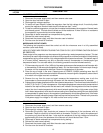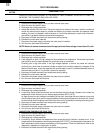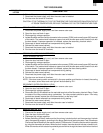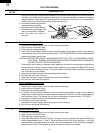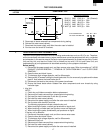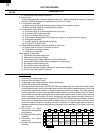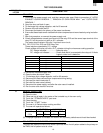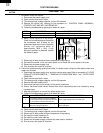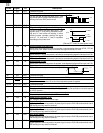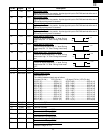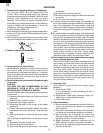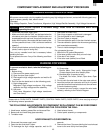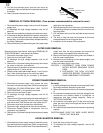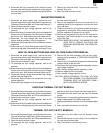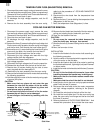
21
R-1500
R-1501
R-1505
R-1506
DESCRIPTION OF LSI
LSI
The I/O signal of the LSI is detailed in the following table.
Pin No. Signal I/O Description
1-2 VL2-VL1 IN Power source voltage input terminal.
Standard voltage for LCD.
3-6 AN7-AN4 IN
Terminal to change cooking input according to the Model.
By using the A/D converter contained in the LSI, DC voltage in accordance with the Model
in operation is applied to set up its cooking constant.
7 AN3 OUT Back light circuit (Light emitting diodes) driving signal.
8 AN2 IN
To input signal which communicates the door open/close information to LSI.
Door close "H" level signal (0V). Door open "L" level signal (-5V).
9-10 AN1-AN0 OUT Terminal not used.
11-13 P57-P55 OUT Terminal not used.
14 CNTR0 OUT
Signal to sound buzzer (2.0 kHz).
A: key touch sound.
B: Completion sound.
TOUCH CONTROL PANEL ASSEMBLY
OUTLINE OF TOUCH CONTROL PANEL
Symbol Voltage Application
VC -5.3V LSI(IC1)
3) Synchronizing Signal Circuit
The power source synchronizing signal is available in
order to compose a basic standard time in the clock
circuit. It incorporates a very small error because it works
on commercial frequency.
4) ACL Circuit
A circuit to generate a signals which resetting the LSI to
the initial state when power is applied.
5) Buzzer Circuit
The buzzer is responds to signals from the LSI to emit
audible sounds (key touch sound and completion sound).
6) Door Sensing Switch
A switch to inform the LSI if the door is open or closed.
7) Relay Circuit
To drive the magnetron, fan motor, turntable motor, hood
motor, and light the oven lamp and hood lamp.
8) Indicator Circuit
This circuit consists of 22 segments and 3 common
electrodes using a Light Crystal Display.
9) Back Light Circuit
A circuit to drive the back light (Light emitting diodes LD1-
LD4).
The touch control section consists of the following units
as shown in the touch control panel circuit.
(1) Key Unit
(2) Control Unit (The Control unit consists of LSI Unit and
Power U nit)
The principal functions of these units and the signals com-
municated among them are explained below.
Key Unit
The key unit is composed of a matrix, signals generated in
the LSI are sent to the key unit through P20, P21, P22, P23,
P24, P25, P26 and P27.
When a key pad is touched, a signal is completed through
the key unit and passed back to the LSI through P43, P44,
P45 and P46 to perform the function that was requested.
Control Unit
Control unit consists of LSI, power source circuit, synchro-
nizing signal circuit, ACL circuit, buzzer circuit, relay circuit
indicator circuit and back light circuit.
1) LSI
This LSI controls the key strobe signal, relay driving
signal for oven function and indicator signal.
2) Power Source Circuit
This circuit generates voltages necessary for the control
unit from the AC line voltage.
In addition, the synchronizing signal is available in order
to compose a basic standard time in the clock circuit.
A
B
0.1 sec.
2.0 sec.
H : GND
L : -5V
H : GND
L : -5V



